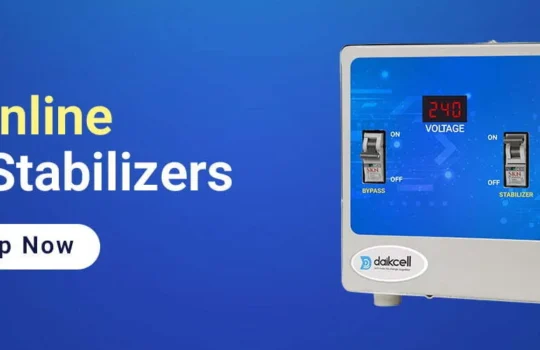Selecting the right voltage stabilizer for your home is vital to safeguarding your electrical appliances. Voltage fluctuations can wreak havoc, causing harm to your gadgets and affecting their performance. But locating the best stabilizer can be a frightening assignment. Let’s dive into the world of voltage stabilizers and discover how to select the one that suits your needs.
Voltage stabilizers, additionally called automatic voltage regulators (AVRs), are gadgets that ensure a steady voltage supply to related equipment. They locate fluctuations and adjust the voltage to supply a strong output—an easy but smart mechanism that protects your appliances from erratic strength delivery.
Why is that important?
Well, believe the frustration of flickering lighting fixtures, shortened bulb lifespans, or poor overall performance of your gadgets because of fluctuating voltage. Your cellphone’s battery life would possibly even go through. Such problems can arise from lightning, line disruptions, or maybe your neighbor’s vacuuming conduct.
This unpredictability poses a threat to your appliances. That’s where a voltage stabilizer for home steps in, mitigating maximum voltage-associated problems—in case you understand which one suits your wishes.
Key Considerations for Selecting a Voltage Stabilizer
Choosing the proper stabilizer includes numerous factors, including:
- Voltage, Power Rating, and Current: Check the sticky label or guide of your devices to determine their voltage, energy, and cutting-edge necessities.
- Max Rated Current Multiplication: Multiply the maximum rated current of all gadgets with the aid of 230 to get the maximum electricity.
- Surge Current: Account for surge currents while devices are growing.
- Listing Appliances: Make a list of all connected gadgets and their respective electricity in watts to calculate the overall load.
- Stabilizer Specifications: Assess the stabilizer’s voltage, present day and strength ratings, output voltage correction time, installation kind, and conditions.
Understanding voltage specifications
Voltage stabilizer for home main line come with specific specifications and operating stages. Knowing the stabilizer’s working voltage range is essential. If your location often reports extreme voltage fluctuations, opt for a stabilizer with a much wider operating variety.
Calculating the right length involves a little math. For example, to decide which device has the most strength, multiply the usual service voltage with the maximum rated modern-day of all devices related. Adding a safety margin of 20–25% to the stabilizer rating is really useful, especially when connecting more than one device.
Most voltage stabilizers are rated in VA or kVA (one thousand volts). A short approximation is to increase the Watts cost by 20% to discover the suitable VA length. For instance, if the full linked Watts are 1000, a 1200 VA or 1.2 kVA stabilizer might suffice for residential setups.
Features to Look For
When purchasing for a stabilizer, make certain it has critical capabilities:
- Wall Mounting: Avoid ground placement because of water contact dangers. Wall-mounting safeguards against electric surprise and saves area.
- LED Indicators: These signs speedily show the stabilizer’s popularity—an inexperienced mild indicates solid voltage, even as crimson indicates issues.
- Time Delay Systems: Useful at some point of power cuts, they help appliances like refrigerators and ACs to stabilize and go with the flow.
- Digital Displays: LED/LCD shows offer information approximately enter/output voltage, temperature, contemporary, reputation, and faults.
- Overload Protection: Essential to shield against brief circuits or excessive masses.
Understanding Appliance-Specific Stabilizers
Different appliances can also require specialized stabilizers based on their power limits and specs. Voltage stabilizer for home main line for fitness center gadgets, TVs, fridges, air conditioners, dishwashers, and more are tailored to their particular requirements.
Navigating the Voltage Stability Landscape
Selecting a voltage stabilizer can be complicated; however, knowing your necessities and the functions of various stabilizers helps make a knowledgeable decision. Feel free to discover our variety of stabilizers appropriate for various equipment types and usage styles.
If you’re uncertain about choosing the first-class healthy stabilizer for your private home, workplace, or industry, look for FAQs on voltage stabilizers or reach out to our representatives for expert steerage.
In a world of unpredictable voltage, choosing the right stabilizer guarantees the longevity and most suitable performance of the electric gadget you love.
FAQs
Q1: How do I decide the proper length of a voltage stabilizer for my home?
Answer: To determine the right length, observe the energy consumption (in watts) of all devices to be connected to the stabilizer. Calculate the full load in watts, and don’t forget a protection margin of 20–25% to locate the precise stabilizer score.
Q2: What are the key specs I ought to take into account before purchasing a voltage stabilizer?
Answer: Check the nominal line voltage, electricity intake variety of your setup, degree of voltage fluctuations, voltage/current/strength scores of the device, type of load, output voltage correction time, installation type, and conditions.
Q3: Should I opt for a wall-established or floor-installed stabilizer?
Answer: It’s really useful to pick a wall-established voltage stabilizer for home main line as it reduces the chance of water contact and electric surprise. Additionally, it saves space and ensures better protection for your home equipment.
Q4: Are there unique stabilizers for exclusive appliances, like air conditioners or fridges?
Answer: Yes, stabilizers are designed for different kinds of systems, primarily based on their electricity limits and specs. There are stabilizers tailor-made for gymnasium devices, TVs, refrigerators, air conditioners, washing machines, and more.
Q5: What if my tool already has voltage stabilization features? Do I still want a stabilizer?
Answer: Some modern appliances come with excessive and occasional voltage reducers, but may not have integrated voltage stabilization. A voltage stabilizer ensures consistent voltage output and prolongs equipment life, making it beneficial even for home equipment with voltage stabilization features.
Q6: How can I check if the stabilizer is functioning well?
Answer: LED indicators at the stabilizer help screen its popularity. A green mild typically suggests solid voltage, while a pink mild indicates troubles that need attention.
Q7: Can I connect a couple of devices to a single stabilizer unit?
Answer: Yes, you can join a couple of devices to a stabilizer. However, it’s important to not forget the full load and upload a protection margin to ensure top-rated overall performance and safety against fluctuations.
Q8: What is the importance of overload safety in a voltage stabilizer?
Answer: Overload protection is crucial because it shuts off the voltage stabilizer‘s output in case of a short circuit or immoderate load, preventing damage to related devices.
Q9: Can a voltage stabilizer protect against sudden electricity cuts or surges?
Answer: While stabilizers in general control voltage fluctuations, certain fashions come with time-put-off structures that assist devices like refrigerators or ACs all through quick-duration strength cuts.
Q10: Are digital signals vital in a voltage stabilizer?
Answer: Digital shows offer real-time facts, approximately input/output voltage, temperature, modern-day faults, and faults, improving the stabilizer’s reliability and usefulness.





